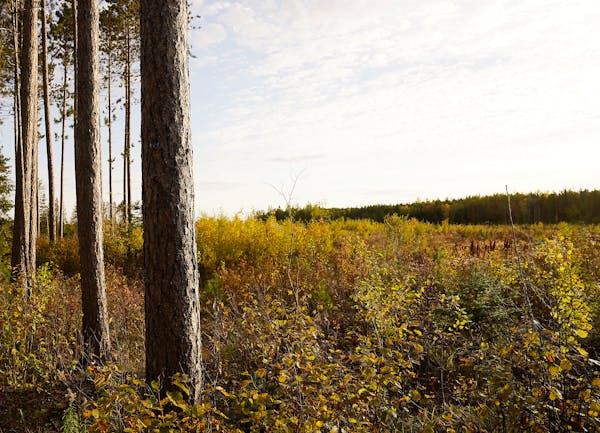To further scrutinize logging practices at the Department of Natural Resources, federal wildlife officials have sharpened the requirements Minnesota must meet before receiving critical funding meant to protect and build wildlife habitat on public hunting lands.
The new "site by site'' demand applies to any proposed cutting of timber on more than 1.3 million acres of wildlife management areas and aquatic management areas across the state. The conditions are a follow-up to a U.S. Fish and Wildlife Service (USFWS) review of the DNR's Sustainable Timber Harvest program, forged more than five years ago to help the state's wood products industry. The review uncovered alleged violations that prompted an unprecedented federal sanction: the temporary withholding from the DNR of $22 million in so-called Pittman-Robertson grant money.
The revised demands — outlined in a $17.5 million Pittman-Robertson award letter issued Dec. 7 to DNR — are meant to ensure that any logging on federally subsidized hunting land in Minnesota primarily serves wildlife, not private companies. Timber harvest is a common tool used by wildlife managers to meet habitat objectives, but the cuttings need to conform to wildlife purposes.
On Wednesday, a public watchdog group based in Washington, D.C., applauded the USFWS for requiring extensive documentation by the DNR and preapproval by the USFWS. The compliance is required before the DNR can offer any timber for sale on subsidized hunting land. The parcels in question have been acquired or maintained with federal aid derived from license dollars and excise taxes related to hunting and fishing. The annual Pittman-Robertson grants help pay salaries at the DNR, among other things.
"It shows how Fish and Wildlife has put a tight leash on the state,'' said Chandra Rosenthal, a regional director of Public Employees for Environmental Responsibility .
DNR Fish and Wildlife Division Director Dave Olfelt acknowledged that the latest Pittman-Robertson wildlife habitat grant includes a revised set of conditions that are "more clear and specific than the last set.'' He said the requirements were developed collaboratively to address previously ambiguous language.
"It's important to understand that the conditions are not substantively different from those in our 2021 grant,'' Olfelt said.
Retired DNR wildlife biologist Gary Drotts and Craig Sterle, a former DNR forester, said Wednesday that the more detailed grant conditions are like an ankle bracelet.
"Minnesota DNR has been put on probation,'' Drotts said.
The revised protocols include a requirement for the DNR to attach a form to each proposed timber sale, including a detailed wildlife assessment justifying the harvest and signed by the local DNR wildlife manager.
Drotts and Sterle belong to an independent stewardship network that watches out for Minnesota's wildlife management areas and aquatic management areas. They said the revised conditions make it clear that the USFWS has removed options for the DNR to gain certain exclusions and waivers when it comes to documenting the wildlife purposes of each proposed timber harvest. That includes required paperwork to comply with the National Environmental Policy Act, they said.
"These grant conditions are very, very detailed,'' Drotts said.
The grant conditions, he said, allow USFWS to monitor logging sites and require performance reports from the DNR that must include disclosure of any staff conflicts that may have developed over the harvest of timber.
DNR Commissioner Sarah Strommen has received complaints about the agency's timber program since the summer of 2019, when 28 DNR field employees wrote to her saying that the new emphasis on cord targets was hurting wildlife habitat and that it was "scientifically dishonest'' for the agency to say otherwise. The employees complained that wildlife protections, including the preservation of older forest types, were being sacrificed to cut timber from wildlife management areas (WMAs) and aquatic management areas (AMAs).
Some of those rank-and-file complaints were validated eight months later when two federal wildlife biologists monitored logging activity at three large Minnesota WMAs. A central finding in the report said: "The primary purposes of the forest management on WMAs seems to be to provide timber for the Minnesota timber industry, accomplish Minnesota DNR forestry goals, and produce revenue for the Minnesota."
The report also cited examples of sloppy logging practices that harmed wildlife habitat, including detrimental slash piles.
It was early August last year when then-USFWS Regional Director Chuck Traxler put a hold on DNR's Pittman-Robertson grant money. In a letter to Strommen, he said the DNR sold logging permits without documenting the habitat purpose of those cuttings. At the time, Strommen said she was comfortable with the nationally unprecedented monetary hold but added that the agency manages for wildlife purposes.
Before the defunding was lifted in October, Strommen attended a staff "Forest Forum'' in Brainerd where she heard a continuation of complaints about the Sustainable Timber Harvest program. At the event, the agency disclosed results of an in-house survey of more than 50 wildlife staff members who have forest management duties. Around 90% of the respondents said they were dissatisfied with DNR logging practices on federal aid lands where wildlife considerations are required to come first.
USFWS regional spokesman Tim Patronski said Wednesday afternoon that the agency was working on a statement about the revised conditions.

Twins rally against Mariners with three last-chance runs and a bunch more in the 10th

Scoggins: Finch's next challenge is to unleash the Timberwolves' youngsters

Analysis: The Timberwolves' offseason, broken down for easy consumption of a complicated topic

Playing without their star, Lynx keep things perfect with comeback at Phoenix

